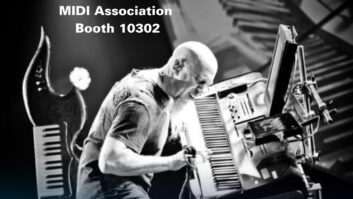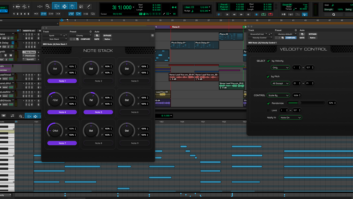In 1983, the Dow Jones average closed at 1,258. A movie ticket cost about $2.50, 3.5-inch floppy disks weren’t available yet, and it would be another year before you could buy commercial CD players from Philips and Sony. Flashdance and Octopussy were big in the theaters. ARPANET officially changed to the Internet Protocol, and so the internet was born…along with Lotus 1-2-3, Microsoft Word and the MIDI specification. MIDI defied expectations, and has lasted over 30 years—unlike ISA, NuBus, SCSI, RS-232 and other specs that are a footnote in computer history.
Craig Anderton When DAT appeared, musicians could drive MIDI instruments with computers into a mastering-friendly medium with sound quality that exceeded all but the finest contemporary analog setups. However, when the Alesis ADAT and Digidesign’s four-channel Pro Tools system arrived in 1992, it looked like MIDI would fade out as digital audio faded in. Then in 1999, Steinberg released VST 2.0, which had the breakthrough feature of allowing plug-ins to receive MIDI data—and the rush of virtual instruments made MIDI more relevant than ever.

At the time, computers weren’t sufficiently powerful to make virtual instruments more than a useful curiosity, but as CPU speeds increased, and 64-bit operating systems accommodated enough RAM to make virtual samplers a practical reality, MIDI was back with a vengeance. Furthermore, with MIDI now flying in and out of computers via USB connections, the bottleneck of a 31.25 kbps serial connection was no longer an issue.
Although Windows 10 has rediscovered MIDI, there’s a lot more going on behind the scenes thanks to the overachieving (and often unappreciated) efforts of the MIDI Manufacturers Association. For example, since 2005, the MMA has been working on a high-definition protocol that’s intended to provide greater data resolution for capturing performance gestures, extend note descriptions and offer more seamless device configuration. Many issues remain to be resolved—not just technical issues, but compliance testing, licensing and other legalities—but there’s movement, and that movement will speed up as more manufacturers recognize the vital importance of the MMA and join the organization.
MIDI has also been part of consumer electronics for a long time, from games to ringtones. One important consumer-oriented initiative, Web MIDI API, is now supported by Google in its Chrome browser for most desktop and mobile operating systems.
Although the Web MIDI API has gained considerable traction among HTML5 game developers, there’s much potential for the future. Basically, the spec connects the cloud to the physical world by sending and receiving MIDI messages to/from a client system’s MIDI devices’ inputs and outputs. This isn’t about SMF playback, but actual MIDI control. MIDI’s low bandwidth and ability to trigger high-quality sounds in the client system (as well the potential for non-music applications, like lighting and home control) make it very web-friendly. Another protocol, MIDI over Bluetooth LE, provides a wireless MIDI connection so that compatible devices can share control and note data—you wouldn’t need wi-fi or a conventional MIDI interface to exchange data between, say, a mobile device and a desktop computer. The LE (low energy) angle matters because it extends battery life for devices that don’t stream data continuously (like MIDI controllers), and battery life is a sensitive topic for mobile devices. Once it becomes easy for products from different manufacturers to work together, MIDI over Bluetooth LE will likely become commonplace.
The MMA is also working on a MIDI-over-USB update to reflect technology changes since 1999, when the USB class-compliant driver spec was first published. The MMA hopes to specify enhancements that allow interoperability at high speeds, as well as support additional data types. In a similar development, the MMA is also looking into enhancing MIDI over Ethernet AVB (Audio-Video Bridging, now called TSS for Time-Sensitive Streams) for low-latency audio/video applications.
Finally, there are efforts to improve Android OS MIDI support. Although the Android OS can already play back MIDI files, it doesn’t allow for sending MIDI messages to its synth, nor has there been a concerted effort among third-party developers to create a native API to allow for simple interoperability among devices.
The above is just a snapshot of what’s going on, and of course, in “technology world,” anything is subject to change without notice. But as MIDI enters middle age, its future remains bright as it continues to expand well beyond its original confines.
Author/musician Craig Anderton has presented seminars on technology and the arts in 38 states, 10 countries, and 3 languages. For his latest music videos, visit youtube.com/thecraiganderton.






